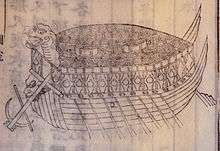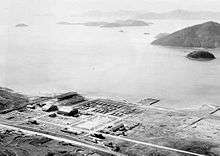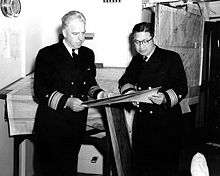History of the Republic of Korea Navy
The Republic of Korea Navy was founded on November 11, 1945 as Marine Defense Group after Korea was liberated from the Empire of Japan. The ROK Navy is the oldest service within the ROK Armed Forces. In 2005, the South Korean navy celebrated its 60th anniversary.
Since the Korean War, the ROK Navy concentrated its efforts to build naval forces against the North Korean navy, which has littoral naval capabilities. As South Korea's economy grew, the ROK Navy was able to build larger and better equipped fleets to deter aggression, to protect national maritime rights and to support the nation's foreign policies.[1] The ROK Navy aims to become a blue-water navy by 2020.[2]
[Note on romanization: In the article, all South Korean ships' names are spelled accordingly with the Revised Romanization of Korean system and supplied with hull numbers in order to avoid confusions. Exceptions are ships named after a person's name (e.g. Chang Bo-go, Yi Sunshin, Sohn Won-yil) because the romanization of the personal name has already been established.]
Origins

Korea has a long history of naval activities. In the late 4th century during the Three Kingdoms Period, Goguryeo defeated Baekjae by operating amphibious forces of 40,000 men. In the 9th century, Commissioner Chang Bo-go of the Unified Silla established a maritime base called Cheonghaejin in an island to foster trading with China and Japan; to cope with pirates.
In 1380, the naval forces of the Goryeo Dynasty defeated 500 vessels of invading Japanese pirates by deploying shipboard guns, devised by Choi Moosun, which is claimed to be the first use of shipboard guns in the naval history. In 1389 and 1419, the Korean naval force invaded Tsushima Island to suppress the Japanese pirate. In the early years of the Joseon Dynasty, the naval forces once reached its peak of 50,000 personnel due to the pirate issue.[4]
During the Japanese invasions of Korea (1592–1598), the Korean naval force commanded by Admiral Yi Sunshin, who later became the head of the Navy (Commander-in-Chief, Three-Provincial Fleet), cut off the invaders' naval life line and defeated the Japanese fleet reversing the war in favor of Joseon.[5] Comparing Yi Sunshin to Lord Nelson, Admiral George Alexander Ballard of the Royal Navy commented: "It is always difficult for Englishmen to admit that Nelson ever had an equal in his profession, but if any man is entitled to be so regarded, it should be this great naval commander of Asiatic race who never knew defeat and died in the presence of the enemy[.]"[6] Admiral Yi is also accredited with improving the Turtle Ship.
By the end of 19th century, the Joseon navy had no significant naval force[7] other than coast defense fortresses. Although there was an attempt to modernize the navy by establishing a royal naval school with the assistance of the Royal Navy personnel, namely Lieutenant William Callwell of the Royal Marines, the Joseon navy (i.e. Commander-in-Chief Three-Provincial Fleet) was brought to an end in 1895.
In 1903, the government of the Korean Empire purchased its first modern war ship, the Yangmu (양무; 揚武; aka Yang Moo), from Japan. She was originally a cargo ship called the Kachidatemaru.[8] The Korean naval tradition was disrupted after Korea was annexed by the Empire of Japan in 1910.
Founding years
.jpg)

Shortly after Korea was liberated from the Empire of Japan on August 15, 1945, a former merchant mariner and independence activist[9] Sohn Won-yil led to form the Maritime Affairs Association. The Maritime Affairs Association evolved in the Marine Defense Group on November 11, 1945 (later became Navy Foundation Day), and some 70 people proceeded to the former Imperial Japanese Navy's Chinkai Naval Station at Jinhae to establish a coast guard academy. Later the name of Marine Defense Group was changed to the Korean Coast Guard. The Korean Coast Guard was officially recognized by the US military government in 1946. Meanwhile, the military government provided limited assistance through U.S. Navy and U.S. Coast Guard personnel then in Korea.[10] After the new Republic of Korea government was established on August 15, 1948, the Korean Coast Guard was formally renamed the Republic of Korea Navy, and Sohn became the first Chief of Naval Operations of the ROK Navy on September 5, 1948.[11]
In October 1949, the ROK Navy purchased a 600-ton submarine chaser, the former USS PC-823 on the American civil market with funds raised among its personnel. She was renamed as ROKS Baekdusan (PC 701) and became "the first significant warship of the newly independent nation"[12][13] (Later on the first night of the Korean War, she sank a 1,000-ton North Korean freighter loaded with 600 troops toward the vital South Korean port of Busan.[14]).
On April 15, 1949, the Republic of Korea Marine Corps (ROKMC) was founded in Deoksan airfield in Jinhae. The Marine Corps carried out Suppression Operations against communist elements in Jinju and Jeju-do.[15]
Korean War and 1950s

The Korean War started with the North Korean army's surprise attack on Sunday, June 25, 1950. The infant ROK Navy confronted threats from the stronger North Korean navy: "Perhaps the most aggressive and effective, if smallest, member of the South Korean armed services during the first year of the Korean War was the Republic of Korea Navy (ROKN). At the outset of the conflict, the 6,956-man ROKN, with [33][16] naval vessels of various types, was outnumbered by the 13,700 men and 110 naval vessels of the North Korean navy."[14] With its UN allies, dominated by US forces, the ROK Navy was able to gain control in the seas surrounding the country; the ROK Navy secured the seas south of the 38th parallel. After the Incheon landing, the ROK Navy proceeded to take control of the entire seas surrounding the Korean peninsula. When UN troops withdrew from the north, due to the entry of Chinese troops, the ROK Navy conducted evacuation operations for the UN troops and Korean refugees with the UN allies. On July 27, 1953, the three-year-long war was brought to an end when an armistice agreement was signed. During the war, Australia, Canada, Colombia, France, the Netherlands, New Zealand, Thailand, the United Kingdom, and the United States contributed naval vessels as UN allies; Denmark sent the hospital ship Jutlandia.[17]
In September of the same year, Commander-in-Chief Republic of Korea Fleet was established. Fleet Aviation Unit was established in 1957.[15]
On July 30, 1960, ROKS Gangwon (DE-72), formerly USS Sutton (DE-771), sank the North Korean navy ship PBS 371 off the coast of Geojin.[18]
1960s
Continuing from the '50s, the ROK Navy continued to build naval surface forces mainly with ships transferred from the US Navy.
In May 1963, the ROK Navy acquired its first destroyer ROKS Chungmu (DD 91 and later DD 911), the former USS Erben (DD-631), a Fletcher class destroyer. On October 3, 1964, ROKS Chungnam (DE 73, later DE 821), formerly USS Holt (DE-706), "successfully prosecuted an unidentified submarine contact for more than 17 hours until the contact surfaced and was positively identified as a Soviet Whiskey class submarine with pendant number 017".[19][20]
During the Vietnam War, the ROK Navy dispatched naval transport units called Baekgu; the ROKMC dispatched combat units called Cheongryong to Vietnam.
In 1969, the ROK Navy began "Isolated Islands Visiting Program" to support people living in small and remote islands around the peninsula.[15]
On January 19, 1967, ROKS Dangpo (PCEC 56), the former USS Marfa (PCE-842), was sunk by North Korean coastal artillery north of the demarcation line off the east coast of Korea[21] (USS Pueblo (AGER-2)) was captured by North Korea in January 1968. In June 1970, a navy broadcast vessel (ROKS I-2) was captured by North Korean patrol craft in the vicinity of Yeonpyeong Islands in the West Sea (Yellow Sea).[22]
1970s and 1980s
_near_San_Diego%2C_CA.jpeg)
In the 70s, the ROK Navy, through the Park Chung-hee Administration's "Yulgok Plan" (an 8-year national defense plan "to build up self-reliant, national defense capability"[23]), began to build naval forces with indigenous technologies; this initiated the ROK Navy to build fleets with locally built ships.
In 1972, the ROK Navy launched its first domestically built patrol craft. The first 2,000-ton frigate ROKS Ulsan (FF 951) was launched in 1980 and the first 1,000-ton corvette ROKS Pohang (PCC 756) was launched in 1982 with indigenous technologies. In the following year, the lead ship of, secretly developed, the Dolgorae class midget submarine was launched.[24] The ROK Navy continued to carry out other new shipbuilding projects such as mine sweepers, logistic support ships and amphibious landing ships.
Fleet Aviation Unit became a fleet aviation group in 1977. The ROK Navy strengthened its naval aviation force by acquiring Grumman S-2 Tracker anti-submarine warfare aircraft and Aérospatiale Alouette III helicopters. In 1986, the fleet aviation group became Air Wing SIX.
In 1973 and 1974, the ROK Navy reorganized its fleets into five Naval Sectors. In 1986, the ROK Navy reorganized its fleets: First Fleet, Second Fleet, and Third Fleet.[15]
In 1973, once a separate branch of the ROK Armed Forces, the ROKMC became a part of the ROK Navy. Headquarters Republic of Korea Marine Corps was established in 1987.
1990s
Since the 90s, the ROK Navy has been steadily upgrading its naval forces. In 1995, Admiral An Pyong-tae, the 20th Chief of Naval Operations, presented the vision of building a "blue ocean navy" for the future of the ROK Navy in his inaugural address.[25]
As a part of a plan to strengthen the surface combatant forces, ROKS Kwanggaeto the Great (DDH 971), the ROK Navy's first locally built destroyer, was launched in 1996; the Kwanggaeto the Great class destroyers replaced the aged former USN Allen M. Sumner class and Gearing class destroyer. For building submarines forces, the ROK Navy acquired its first submarine (excluding midget submarines) ROKS Chang Bogo (SS 061) from Germany in 1992. The following eight Chang Bo-go class submarines were built in Korea. In order to replace the aged S-2 Trackers, Lockheed P-3C Orion maritime patrol aircraft were delivered to the ROK Navy from 1995.
In November 1999, the ROK Navy completed the construction of Pyeongtaek Naval Operations Base; Commander Second Fleet was relocated from Incheon Naval Base to the newly established base with an operational headquarters.
In October 1998, the ROK Navy hosted its first International Fleet Review in commemoration of the 50th anniversary of the Republic of Korea and its armed forces off coast of Busan and Jinhae. About 60 ships from 12 countries participated in the fleet review including the South Korean navy.[26]
In June 1999, the ROK Navy forces engaged the North Korea naval forces near the Northern Limit Line (NLL) in the vicinity of Yeonpyeong Islands. In June 2002, the two Navies engaged again in the same vicinity resulting in the sinking of ROKS PKM 357.
Present: First decade of 21st century
.jpg)
The ROK Navy continues to put its efforts to build a "blue ocean navy". In 2001, then President Kim Dae-jung announced a plan for building up the Strategic Mobile Fleet.[27]
In 2002, the lead ship (DDH 975) of the 4,500-ton Chungmugong Yi Sunshin class destroyer was launched. In 2005, the 14,000-ton amphibious landing ship, ROKS Dokdo (LPH 6111) was launched. In 2006, the ROK Navy launched the lead ship (SS 072) of the 1,800-ton Sohn Wonyil class submarine, which was named after the first Chief of Naval Operations, equipped with Air-Independent Propulsion (AIP) system. In May 2007, the ROK Navy launched the lead ship (DDG 991) of the King Sejong the Great class destroyer, built around the Aegis combat system and the SPY-1D multi-function phased array radar. In June 2007, the ROK Navy launched the lead ship (PKG 711) of the Yoon Young-ha class missile boat in honor of the late captain of ROKS PKM 357, which was sunken after an engagement with the North Korean navy in 2002.
The ROK Navy completed the construction of Busan Naval Operations Base in June 2006; Commander Third Fleet was moved to the newly established operational headquarters.[28] In November 2007, Commander Third Fleet was relocated to Mokpo while disestablishing Mokpo Naval Sector Defense Command. In December 2007, Commander-in-Chief Republic of Korea Fleet (CINCROKFLT) moved its command headquarters from Jinhae Naval Base to Busan Naval Operations Base. Jinhae had been CINCROKFLT's homeport since 1953.[29]
As a part of its mission, the ROK Navy participated in several peacekeeping operations since the turn of the century.[30] In 2004, the ROK Navy hosted a multilateral naval exercise - Pacific Reach 2004 - for the first time.[31] The Cruise Training Fleet - ROKS Chungmugong Yi Sunshin (DDH 975) and ROKS Cheonji (AOE 57) - visited the United Kingdom in order to take part in the International Fleet Review for Trafalgar 200 in 2005. In 2010, ROKS Cheonan sinking occurred in Yellow Sea.
See also
Notes
- ↑ "해군의 역할". Republic of Korea Navy official website. Retrieved March 8, 2007.
- ↑ "대양해군건설". Republic of Korea Navy official website. Retrieved March 4, 2007.
- ↑ Stephen Turnbull, Samurai Invasion. Japan's Korean War 1592-98 (London, 2002), Cassell & Co ISBN 0-304-35948-3, p. 243
- ↑ "역사속의 해군". Republic of Korea Navy official website. Retrieved May 1, 2007.
- ↑ "Korea's Legendary Admiral (PDF Format)". barrystrauss.com. Retrieved May 1, 2007.
- ↑ Ballard, G.A., 1972, The Influence of the Sea on the Political History of Japan., Greenwood Press Reprint, pp. 66–67.
- ↑ "The First US Naval Attaché to Korea". Central Intelligence Agency official website. Retrieved May 6, 2007.
- ↑ "제3장 군사학교의 설립과 사관양성 (PDF Format)". Ministry of National Defense - Institution for Military History Compilation official website. Retrieved May 1, 2007.
- ↑ "손원일 중장". War Memorial Museum official website. Retrieved May 2, 2007.
- ↑ "THE FORGOTTEN SERVICE IN THE FORGOTTEN WAR". U.S. Coast Guard official website. Retrieved March 23, 2007.
- ↑ "Commander, U.S. Naval Forces Korea: The Early Years (1945 to 1957)". Commander U.S. Naval Forces Korea, U.S. Navy official website. Retrieved March 4, 2007.
- ↑ "Pak Tu San (Submarine Chaser # PC-701, 1950-1960)" Department of the Navy – Naval Historical Center official website. Retrieved March 4, 2007.
- ↑ "한국해군50년사". Republic of Korea Navy Official website. Retrieved March 4, 2007.
- ↑ "6·25전쟁 발발 당일, 우리 해군의 함정 척수 및 병력". 해군 vol. 2003 9-10. Republic of Korea Navy. Retrieved October 21, 2007.
- ↑ "Allied Forces in the Korean War". Department of Defense – Korean War Commemoration website. Retrieved September 25, 2007.
- ↑ "잊혀진 해전". 해군 vol. 2008 1-2. Republic of Korea Navy. Retrieved June 12, 2008.
- ↑ "Commander, U.S. Naval Forces Korea: Abbreviated History of Commander, U.S. Naval Forces, Korea". Commander U.S. Naval Forces Korea, U.S. Navy official website. Retrieved October 4, 2007.
- ↑ 姜泳勳. (1996). 73艦의 蘇聯 潛水艦 追跡事件. 海洋戰略 vol. 93. South Korea: 海軍大學 pp.1-41.
- ↑ "Marta". Department of the Navy – Naval Historical Center official website. Retrieved April 30, 2007.
- ↑ "남북간의 해상전과 남한 방송선 피랍사건". www.ceoi.org by O Wonchol. Retrieved October 4, 2007.
- ↑ "ROK Army History". GlobalSecurity.org. Retrieved March 10, 2007.
- ↑ "철모에서 미사일까지<128>첫 독자 개발 소형 잠수함-22-". The Korea Defense Daily. Retrieved March 10, 2007.
- ↑ "21세기 통일한국의 大洋해군 전략". Donga.com. Retrieved March 8, 2007.
- ↑ "{해군 국제관함식} 바다로, 세계로...". THE HANKOOKILBO. Retrieved March 10, 2007.
- ↑ "김대통령, 해군사관학교 졸업 및 임관식 참석말씀". Kim Dae-jung Presidential Library official website. Retrieved March 12, 2007.
- ↑ "해군,「부산 작전기지」준공". Republic of Korea Navy Official website. Retrieved March 20, 2007.
- ↑ "작전명 일출 … 해작사 부산상륙". Joins.com. Retrieved December 4, 2007.
- ↑ "해군작전사령부 창설 54주년..어제와 오늘 그리고 미래". Ministry of National Defense Official website. Retrieved March 4, 2007.
- ↑ "PACIFIC REACH". Republic of Korea Navy official website. Retrieved March 10, 2007.